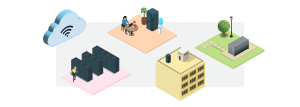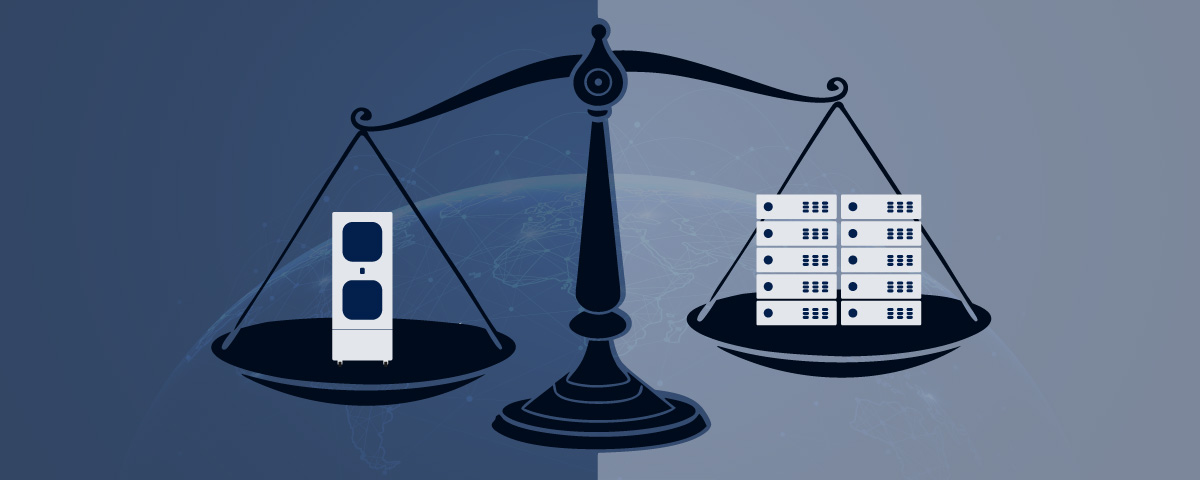Data storage is evolving. We’ve come a long way from the computer rooms of the mid 20th century, with multiple options available depending on individual requirements. While the cloud was the darling of the early 21st century, the options for today’s data preservation have increased dramatically. Companies can even utilise hybrid models that take advantage of two different storage solutions.
So what are the different types of data centres and which solutions is the best for your environment?
1. Cloud
The progress of data storage certainly doesn’t mean the cloud is becoming obsolete – far from it. We only need look at how big tech is increasing its storage capacity to cope with the burgeoning demand. According to global cloud-based communications company Cision, 90% of companies around the world use the cloud as a storage option.
Its popularity is obvious: infinite capacity, value for money, reliable… What’s not to like? However, the downside of cloud storage is already beginning to show with the increase in IoT and the need for instant data transference with no latency. As we further advance and turn more of our lives over to smart devices, so this issue will increase.
Therefore, cloud storage is great in situations where those tiny time lags don’t matter – but other, more appropriate, options are ready and waiting for when this staple storage behemoth doesn’t quite hit the spot.
2. Server Room
While still very much in use, server rooms can almost be thought of as the grandfather of data storage. They’re the modern version of the old-style computer room – swathes of space given over to drives that hold data for a company. While they keep this information securely on site, the downsides are that they’re hugely expensive to run, take many months (or years) to implement, are virtually impossible to relocate, plus they take up valuable real estate.
Larger companies continue to utilise server rooms. But for SMEs they’re often not a viable option due to the high expense involved.
3. Colocation
This is where a company rents equipment, space, and bandwidth directly within an external data centre. This means they have control of the hardware without the hassle and expense of setting up a server room, nor any of security worries that can sometimes be associated with cloud storage.
Colocation is highly popular, especially amongst SMEs that want the advantages of a big IT department without the associated costs.

4. Micro Data Centre (MDC)
A micro data centre is a small, self-contained unit that stores data. Offering portability and whisper-quiet, on-site storage, this is a great alternative to a server room – especially where space is at a premium.
An MDC is ideal in environments, such as an office, where its small size and virtually silent operation means it can be sited anywhere – even next to or under a desk. No special skills are needed to maintain an MDC and if more data storage is needed you can simply add an additional unit.
A market-leading example is the Zella Pro. This comes in three different sizes, meaning even the tightest of spaces can accommodate this cutting-edge data storage solution.
5. Outdoor Data Centre
Another type of MDC that, as the name suggests, can be situated outside. It’s perfect for environments with limited infrastructure, such as unreliable power supplies or in remote locations. Wholly weatherproof, an outdoor data centre is resistant to all environmental challenges, meaning it can be sited anywhere. Similar to the MDC already discussed, an outdoor data centre comes in different sizes according to storage needs.
As IoT and Edge devices become more widespread, so outdoor data centres provide the ability to store the large amounts of data generated close to the action. They can also be connected to solar and wind power sources and are the answer for any smart-run application, such as smart farms, smart mines, telecom towers, 5G etc.
The Zella Outback is proving its worth in many locations within Australia and further afield.
6. Containerised Data Centre
When on-site storage needs increase, then a containerised data centre could well the answer. Again, these are sited outside and contain any configuration of MDCs to cope with large amounts of data storage. These large-scale, plug ‘n play solutions are designed to a user’s specification and can be scaled according to need. If more storage is required, the containers can be stacked on top of each other to increase capacity.
Containerised data centres work for both permanent and temporary locations, such as defence outposts. They’re portable – they can be moved on a truck – and are also ideal for multi-tenant sites and joint operations.
The Zella Max provides incredible storage capacity and versatility to suit any business needs.
7. Hybrid Storage
In many situations, the hybrid model is this is the ideal solution. It combines both cloud and on premises storage, with the latter either in the form of a server room or the increasingly popular MDC option. This offers the best of both worlds, providing infinite capacity plus all the advantages that on-site storage brings.
As data needs continue to evolve, so too do the choices for where it’s stored. The different options mean that companies need to consider which works best for their needs. Getting this right has many benefits – from security and costs through to the vital aspect of environmental responsibilities.






